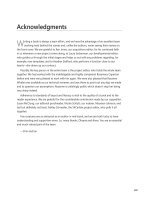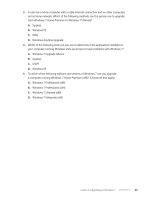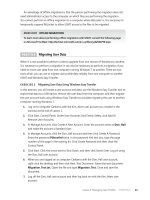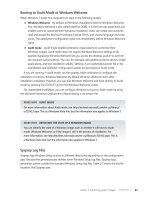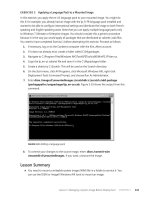Configuring Windows 7 (Training Kit) - Part 64 ppt
Bạn đang xem bản rút gọn của tài liệu. Xem và tải ngay bản đầy đủ của tài liệu tại đây (575.01 KB, 10 trang )
Lesson 1: Updating Windows 7 CHAPTER 12 603
n
Optional Updates Optional updates provide items such as driver updates and
language packs. Figure 12-3 shows the Russian Language Pack, which is an optional
update for Windows 7.
FIGURE 12-3 Optional language pack update
How Windows Update deals with this update depends on how you have configured update
settings. You can manually configure how Windows Update deals with updates by clicking
the Change Settings item. This opens the Change Settings dialog box, shown in Figure 12-4.
Through this dialog box, you can configure how Windows 7 deals with important updates, the
frequency at which updates are checked, whether recommended updates are treated in the
same fashion as important updates, and whether users without administrative privileges are
able to install updates on the computer. Only users with administrative privileges are able to
change Windows Update settings. The options that you can configure with this dialog box are
as follows:
n
Install Updates Automatically (Recommended) Windows Update installs updates
automatically at the time specified. This is the default setting for Windows Update.
n
Download Updates But Let Me Choose Whether To Install Them Updates are
downloaded to the computer, and the user is notified that the updates are available for
installation.
n
Check For Updates But Let Me Choose Whether To Download And Install Them The
user is notified that updates are available for download and install.
n
Never Check For Updates (Not Recommended) Windows Update does not check for
updates, but updates can still be checked for and installed manually.
n
Give Me Recommended Updates The Same Way I Receive Important Updates This
means that Recommended Updates are treated in the same manner as Important
Updates. Optional updates still need to be installed manually.
n
Allow All Users To Install Updates On This Computer This option is enabled by
default. If you disable this option, only user accounts that are members of the local
Administrators group can install updates.
6 0 4 CHAPTER 12 Windows Update and Windows Internet Explorer
FIGURE 12-4 Changing how Windows can install updates
The View Update History control panel, shown in Figure 12-5, allows you to view a list of all
updates that have been successfully or unsuccessfully installed on a computer, as well as the
date they were installed and their importance classification. Clicking on an update within the
View Update History control panel allows you to find out more information about the update.
This information provides a summary of the update and also provides a link to a Knowledge
Base article that also provides detailed information about the update. Knowledge Base articles
also provide information about any potential problems that an update might cause. If you
install an update on a client running Windows 7 and start experiencing problems, you should
consult the Knowledge Base article related to the update to determine if these problems have
been documented and if there are any workarounds to deal with the issues related to the
update. Knowing the Knowledge Base ID of an update is also important if you want to delete
the update. The Knowledge Base ID is a six-digit number, often preceded by the letters KB,
such as KB123456.
When reviewing updates that are available for installation, you can also right-click an
update and select Hide Update. Choosing to hide an update effectively declines the update.
This means that the update does not install and that Windows Update does not present that
particular update for installation through Windows Update in the future. Only users with
Administrative privileges are able to hide updates. Declining an update does not mean that
the update cannot be installed at a later stage. Through the Restore Hidden Updates item
in the Windows Update control panel, you are able to restore updates that were hidden in
the past. Restoring a hidden update means that the update will be available the next time an
update check occurs. The Restore Hidden Updates control panel is shown in Figure 12-6.
Lesson 1: Updating Windows 7 CHAPTER 12 605
FIGURE 12-5 Viewing update history
FIGURE 12-6 Restoring hidden updates
It is possible to uninstall an update that has already been installed. A user who is a member
of the local Administrators group can uninstall an update. This is done through the Programs
and Features control panel. You can also access this panel by clicking the Installed Updates
item in the Windows Update control panel. Unlike the View Update History dialog box, you are
presented only with the Knowledge Base identifier of the update. This means that you must
know the Knowledge Base identifier of an update to uninstall it. As you learned earlier, you
can determine the Knowledge Base identifier of a particular update by using the View Update
606 CHAPTER 12 Windows Update and Windows Internet Explorer
History control panel and double-clicking the update. This displays an update information
dialog box from which you can determine the Knowledge Base ID, as shown in Figure 12-7.
FIGURE 12-7 Update information
When you uninstall an update, it does not appear in the list of hidden updates, but it does
become available again if you check for new updates. It is important to remember to hide
any update after you uninstall it. For example, you might install an update only to find that
it causes a conflict with some custom software deployed in your organization. You choose to
uninstall the update to restore the functionality of the custom software. You can then use the
Hide Update function to hide the update until the software vendor is able to develop a fix
that makes the custom software compatible with the update. This will ensure that other users
who have the ability to install updates do not inadvertently install the update until the custom
software fix is available. Figure 12-8 shows the Installed Updates control panel, from which
you can uninstall an update.
FIGURE 12-8 Uninstalling an update
Lesson 1: Updating Windows 7 CHAPTER 12 607
Updates for Other Microsoft Products
The default Windows Update settings retrieve updates only for the Windows operating system
and included applications. You can upgrade Windows Update so that updates for all Microsoft
software, including Microsoft Office, can be detected and installed through Windows Update.
To do this, click the Find Out More item next to Get Updates For Other Microsoft Products.
This opens a Web page that hosts an update allowing you to extend the functionality of
Windows Update. Installing this update adds a section to the Change Settings control panel,
shown in Figure 12-9, that allows Windows Update to provide update for other Microsoft
products. It is also possible for Windows Update to deliver updates that are available from an
alternate update source like WSUS. You will learn about WSUS later in this chapter.
FIGURE 12-9 Updates for other Microsoft products
Configuring Windows Update to Use a Proxy Server
Occasionally, on networks that have specific firewall and proxy configurations, Windows
Update clients are unable to contact the Microsoft Update servers on the Internet. There are
several ways to deal with this problem. The first is to deploy a WSUS server on the local area
network (LAN) and have the clients download updates from the WSUS server. When setting up
the WSUS server, you can configure it to use the proxy. Alternatively, it is possible to configure
a client running Windows 7 manually so that Windows Update can communicate with the
Microsoft Update servers through the proxy. Although you can configure Internet Explorer to


